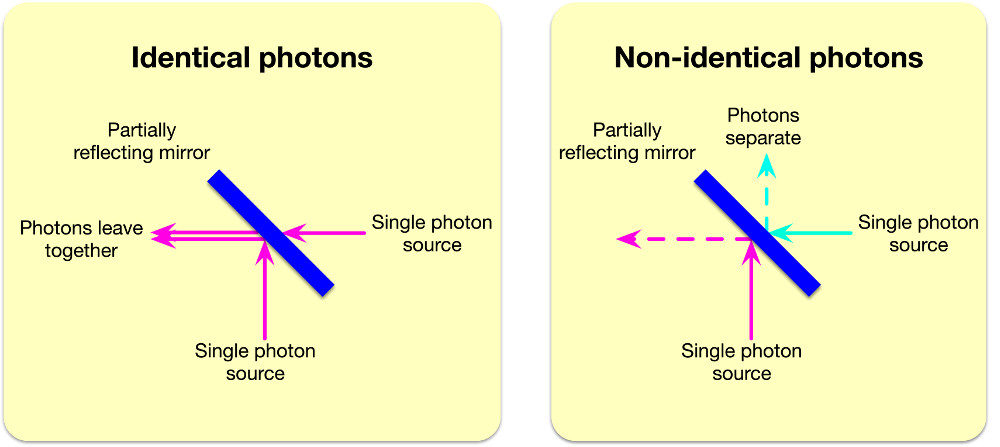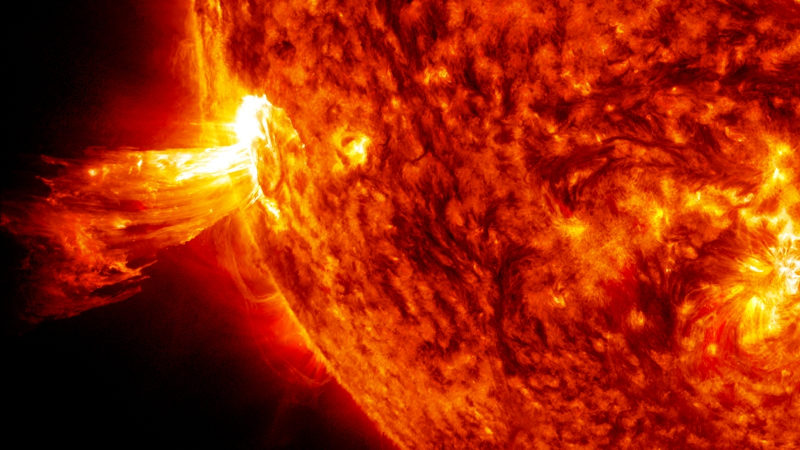That began the photon gold rush, with scientists identifying all sorts of interesting potential behaviors. But actually observing them would require having rather special light sources, which didn't exist. Now, scientists have shown that our own Sun can be turned into one of these light sources.
A herd of identical photons
When two photons are indistinguishable, they can be made to play some unexpected tricks. The diagram below shows an example: two identical photons hit a partially reflective mirror at the same time. We cannot predict where they will go, but wherever it is, they go together. If the world was classical, we would expect that each behaves independently, and half the time, they would choose different directions. But we're in a quantum world, so this doesn't happen.

But these were single devices that, by their construction, could do nothing other than generate pairs of identical photons. Could two independent devices emit single photons that are identical to each other?
The development of quantum dots made that possible. Quantum dots are what the label on the box says: tiny dots of material that produce quantum behavior by confining a single electron. The confinement restricts the electrons to specific energies; when the electron gets rid of energy, it does so by emitting a photon.
Material scientists have figured out how to make these dots so that they are all almost identical, meaning that the color of the emitted photon is the same. We also know how to place them in surroundings that encourage them to have the same purity, spatial shape, and polarization. Experiments revealed that two quantum dots can, indeed, emit identical photons.
However, this still doesn't quite cut it. We have essentially made two copies of the same device and carefully controlled the environment to ensure that they would naturally produce identical photons. But what about something beyond our control, like the Sun?
Cutting identical photons out of a mixed herd
This is exactly what a team of researchers has tested. They used a tracking device to continuously capture light from the Sun. That light was filtered to ensure that only photons with the right color, purity, spatial shape, and polarization were saved. These were then sent to a partially reflecting mirror along with light from a quantum dot.
But timing is also critical, as the experiment requires that only a single photon from the Sun hits the partially reflecting mirror at the same time that the photon from the quantum dot arrives. The Sun emits photons at random times, but there are so many photons that there are always many more than one available, while a quantum dot only emits a photon every 10ns or so.
To clear the timing hurdle, the researchers threw away photons from the Sun until the average photon rate was about the same as that of the quantum dot. Then the detectors were only switched on at specific time intervals, effectively choosing only to detect photons that arrive along with the photon from the quantum dot.
Under these conditions, the result was exactly as predicted for indistinguishable photons. Well, almost. The quantum dot isn't perfect, so sometimes it emits two photons instead of one. And the photon stream from the Sun will also occasionally have two photons, meaning that the researchers don't see perfect interference.
But it's pretty close. In fact, their results were so good that they went a step further, showing that they could entangle photons from the Sun with photons from a quantum dot.
On one level, this is pretty ordinary: quantum mechanics predicts that identical photons will behave a certain way. This experiment effectively takes the countless photons from the Sun and selects only those that are identical to the photons from the quantum dot. We wouldn't expect any other result.
On another level, this is still pretty incredible. To think that we now have the technology to take any old light bulb and turn that into a quantum resource is pretty amazing. The researchers also claim that the quantum properties of single photons from the Sun can be used to throw light on solar processes, like magnetic field behavior. That may be more interesting than any technological application.
Reference: Physical Review Letters, 2019, DOI: 10.1103/PhysRevLett.123.080401




Reader Comments
Articles like this one are written as if what they say is true and not disputed which simply not true.
Just look at this claim. Source?
"Up until the mid-20th century, light was pretty ordinary. Yes, it was both a particle and a wave, but it didn't do anything very weird. Then scientists, under-employed after the end of World War II, started paying more attention to the properties of light. This was, in part, driven by the availability of surplus searchlights, which could be turned into cheap arrays of light detectors to measure the properties of stars."
A complete invention. First of all less than 2% of the population in the US even had a 4 year degree of any kind in the United States after WWII. Scientist's were not starving I assure you. Christ sakes, here you're talking about the most desirable personnel and of which there were very few. Hardly under employed, surplus search lights? Seriously?
The energy of a single photon is also very small and the mirror might not have an energy level available to either absorb or give up the exact amount of energy required to allow identical photons to take different paths.
Theoria Apophasis
FIELD Theory in Depth: Fake Particle-Fantasy pseudo-science of Quantum & Relativity
[Link]
[Link]
[Link]
The Code Theoretic Axiom
[Link]
How about reasonably explaining first why sun spots, revealing inner layers, are cooler than the surface.